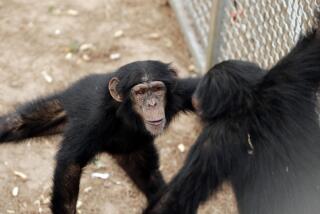DNA Opens Doors to Animal Kingdom
- Share via
GLACIER NATIONAL PARK, Mont. — Wildlife biologists have discovered something of a time machine, a tiny transport to the past woven tight into the nucleus of animal cells.
The twisted double helix of DNA is slowly being unraveled, helping wildlife researchers pursue mysteries across both time and space.
“What we have here is a whole new way of looking at the world,” said Kevin McKelvey, a research ecologist working for the Forest Service. “We’re just now learning how to use these incredibly powerful tools; no one even knows how much will be possible.”
Scientists already have pegged accurate estimates of the number of grizzly bears in Glacier National Park through DNA analysis. They have determined that the giant panda bear is, in fact, a bear; and they have determined that female marmots, once thought to be loyal to their mates, actually fool around quite a bit.
Now science is using DNA to answer riddles about the past. Researchers can compare the genes of today’s bears to those that roamed 30,000 years ago. They can compare Montana’s bears to Siberia’s bears. They can ferret out corridors of rich genetic diversity, determine the relatedness of species, even re-create 18,000-year-old Pleistocene ice flows.
“We’re beginning to answer the really cool questions, the questions biologists have been wanting to answer for a long, long time,” Lisette Waits said.
Waits is a professor in the Department of Fish and Wildlife at the University of Idaho, where she operates a lab that analyzes DNA samples that wildlife biologists around the world have submitted.
Analysis of genetic samples, she said, began in the early 1980s.
Back then, scientists were just starting to gather protein data to better understand evolutionary biology. They could analyze the proteins from bits of animal flesh and use the findings to determine, for instance, whether the panda indeed was a bear.
Many similar taxonomic riddles, which had vexed biologists for decades, fell easily before the protein analysis.
Proteins were important because they are fundamental building blocks of life. They are made up of amino acids, which in turn are made up of DNA. The DNA alphabet contains just four letters; A for adenine, G for guanine, C for cytosine and T for thymine. Those four chemicals combine to create the amino acids, which combine to create the proteins scientists were so excited about in the early 1980s.
The problem with the new technique, however, was that it was severely limited by technology. In the early days, biologists had to snip a tissue sample from a live animal, immediately freeze it in liquid nitrogen, rush it to the lab and hope it hadn’t been thawed or been contaminated along the way. Once in the lab, the sample was subjected to analysis techniques that are crude by today’s standards, Waits said, offering at best an extremely low resolution picture.
All that changed, however, with the 1986 invention of the polymerase chain reaction, or PCR. That groundbreaking technique allowed scientists such as Waits to copy a specific piece of DNA and then amplify it.
Technicians could take a single hair and determine the species it came from, the individual animal it belonged to, its gender, its relationship to others.
Researchers such as Kate Kendall quickly seized on the high-tech tools to augment wildlife study methods. Based in Glacier National Park, Kendall is a grizzly bear researcher. In recent years she has used DNA analysis to estimate the number of bears in the region, their territorial distribution, their gender makeup and relationship to adjacent populations.
Similar work has begun in Glacier with lynx, a secretive forest cat recently given protection under the Endangered Species Act.
“This approach is just exploding around the world,” Kendall said. Canadians are using it to count wolves, Africans to count tigers, Japanese to count bears.
But counting animals was just the tip of the genetic iceberg. Disciplines such as phylogeography boomed, as scientists now could determine the genetic relationships between populations of the same species separated by vast distances. Mixing biology with evolutionary history and geology, scientists began to use DNA to see what the world looked like in ages past.
Researchers studied the DNA of Egyptian mummies, of extinct mammals, of frozen mammoths, of ancient human remains. Genetic analysis proved an ancestral link between hermit crabs and king crabs.
Museum specimens of fish scales were compared to modern fish DNA to establish the effect of hatcheries, Waits said. Grizzly bear hides from California and Colorado were compared with modern bears to determine what was lost in the way of genetic diversity when humans shot those bears into extinction.
A study of wildflowers helped to explain where the ice sheets inched along 18,000 years ago.
Some of the most rigorous studies of ancient DNA have focused on a Miocene-era lake bed that silted in about 20 million years ago near the present-day town of Clarkia, Idaho. There, in the oxygen-deprived sediment, are ancient leaves that still show photosynthetic green or the reds of autumn days.
Studies of those leaves indicate, among other things, that the bald cypress has not changed or evolved genetically in 20 million years.
Scientists still have to be careful about which tools they use to answer a particular question about a particular species, said Steve Gniadek, wildlife biologist at Glacier National Park. And even with high-tech techniques, he admits, there are still a handful of assumptions that must be made in any study, assumptions that might taint pure results.
And the older the DNA, the greater the number of variables. Genetic markers deteriorate with time, and become contaminated by the DNA of other species. That often makes studying very old samples nearly impossible. And studying modern samples has its own set of problems.
“My guess is that we’re just beginning to understand how important this tool is going to be,” McKelvey said. “I think we’re just scratching the surface.”






